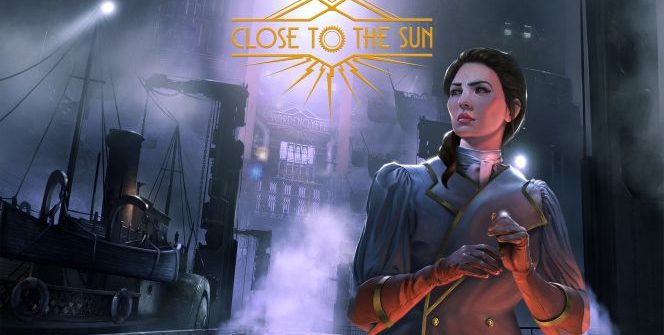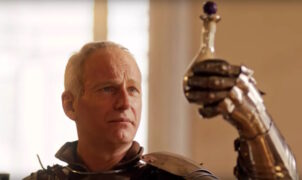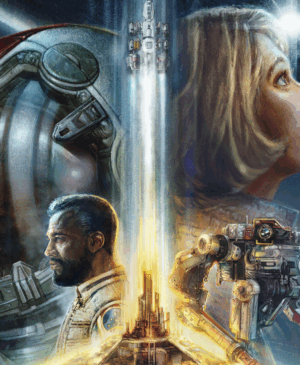REVIEW – It was a long time ago when we last saw a good first-person story-driven game come out. Unfortunately though, if you were waiting for one that you can finally immerse yourself in, you’ll have to wait longer. Close to the Sun is here but its sun doesn’t shine as bright as it should.
I won’t gonna sugarcoat it: Close to the Sun is immensely disappointing and kinda bad. The only two redeeming qualities of this game are the sometimes good dialogues and the standout art style (including the world design) that together can create some fun and enjoyable moments that are able to elevate the product from the absolute mediocrity.
I think these were the main reasons why a lot of players had high hopes for this title. They saw the insanely captivating and unique world, they have heard some good lines from the characters and this gave them the natural conclusion – which was rather an illusion – that it was going to be another great and immersive story-driven first-person game, similarly to the ones like Firewatch, Observer, or Soma.
And to be quite frank, I was looking forward to playing this game too, because it’s hard to not get impressed by seeing something like this. In some ways, in some moments, it looks like nothing I’ve seen before or at least nothing I’ve seen before in the world of games. It reminded me of Alex Proyas’ hidden masterpiece, Dark City in its opening moments and also The City of Lost Children, which is another great thought-provoking movie from the ‘90s. But even in its more “familiar” moments, I’ve seen a heavy resemblance with such iconic game titles as Dishonored, or Bioshock.
However, as much as it looks great, these striking visuals can’t negate the obvious shortcomings and problems of the title. Problems that run far and deep in terms of gameplay, storytelling and also in terms of technical aspects.
Storytelling and lore
The story of Close to the Sun starts out relatively interestingly. Our main character, Rose Archer, receives a letter from her sister, who is a highly acclaimed scientist and is currently aboard the Helios, which serves as a haven for the greatest scientific minds. It’s the brainchild of Nikolai Tesla and it’s an unbound utopia for research, which is independent of state and isolated from the gaze of society. It’s the eighth wonder of the world, or at least that’s how it is being referenced to in the game.
When Rose steps aboard the Helios in order to find her sister, Ada, that’s where our journey begins (excluding the prologue). Basically, everything that could go wrong goes wrong and after that, our only goal will be to survive and escape from this place that turned into a living nightmare. Sounds interesting, right?
It sounds interesting, but it is not. While there are some good moments that come from the strong line delivery from the voice actors and from the sometimes good dialogues, in the end, ultimately the story simply crumbles under its own weight. There are a lot of cool concepts and themes that the game throws up carelessly, such as time-travel or parallel dimensions (sort-of), only to never bother enough to actually delve deep into any of these. Basically, the title is full of unexplored concepts and ideas in terms of storytelling and world building.
What doesn’t help either is that the whole game ends before it even begins? It feels like it is struggling with The Order 1886 syndrome. It feels like a sequel-bait rather than a self-contained and satisfying story. There’s barely enough worthy material in there to keep you interested in playing.
Not just because there are a lot of ideas that are just there to be there without any real purpose, but because the actual story is pretty uninteresting, not very well paced and it lacks the level of suspense and emotional weight that would be essential to make it effective. The characters don’t really have any arcs, while you can see the twists of the story coming from miles away and they feel extremely cheap… and then the game ends abruptly with a pretty lame cliffhanger and you’ll be left with the feeling that you didn’t really achieve anything and you didn’t really learn anything either.
As a final point in discussing the story, I also want to mention that the different readable items (blueprints, newspaper articles, etc.) that were supposed to deepen the lore were pretty underwhelming too. A lot of these are nothing more than basic details about some characters that were working aboard the Helios (how old are they, what is their gender, etc.), or uninteresting writings that didn’t manage to add anything meaningful to the world of the game.
By being said all of these, I decided to didn’t reveal any actual plot details that could be considered as spoilers. I was intentionally vague because despite my feelings, maybe some people will find this story worth experiencing, even if only for the sake of a discussion.
Gameplay
Close to the Sun is the perfect example of why games in this genre are commonly get labelled as “walking simulators”, even if some are much more than that. Firewatch, Soma and Observer definitely acts as the golden standards in the genre of first-person immersive story-driven titles, because aside from telling a strong and effective story, they managed to include some level of player choice, along with a higher level of player interaction and with some meaningful and satisfying exploration.
Which game has none of those? Well, a couple of games, such as Everybody’s Gone to the Rapture, Virginia, and yeah, you’ve guessed it, Close to the Sun. What I want to make clear is that these games are simply not the ideal representations of this genre and therefore these do not show what it is truly capable of. It’s just wrong to base our opinions about these types of games based on titles like these. It’s like saying horror movies are all bad because all you have seen is Final Destination and Saw sequels and you think the genre is nothing more than an excuse for an unnecessary amount of gore and torture. While the truth is you just haven’t seen good horror movies (such as The Shining, It Follows, Cabin in the Woods, The Thing, The Blair Witch Project, etc.).
By being said that, Close the Sun is not one of the good ones in its genre, and there are a couple of reasons why. Interactivity is key, that’s the central point in the medium of videogames and if your work can be translated to other mediums without losing anything of what made it what it is, then comes the obvious question: what was even the point of making a game out of it? Or the better question: if your game doesn’t have any values that are only possible because of the presence of interactivity, then why didn’t you just make something else? A visual novel? A comic? Or a movie?
So the thing is that Close to the Sun’s level of interactivity is pretty meaningless. It’s not as bad as in the case of Virginia but that doesn’t say a lot considering the player was basically a passive inspector of the events in that game. In Close to the Sun, there are certain things you can do. You can open some doors using wall panels, pick up items at certain points of the game and sometimes solve puzzles (although saying those are puzzles requires a ton of goodwill from me). Oh, and you can jump too. But the reality is that all of these are nothing more than artificial obstacles that are just there to extend gameplay length and give you, the player a false sense of interaction and choice. This becomes pretty obvious when you realize that the dedicated jump button has absolutely no use or purpose in the game because you can’t even jump through the smallest holes or obstacles – believe me, I tried… a lot.
Level design is also quite problematic – and I was very generous by saying that. It’s unbelievable how an aspect of the game managed to fail in every single thing that it was supposed to do. First of all, while the game is extremely linear, it’s quite common to get lost, that leads to a lot of wondering about where to go next. Sometimes for just fractions of a minute, sometimes for multiple minutes. Regardless of the time, this is simply unacceptable, especially from a title like this. I remember playing Doom (2016) and the fact that it had a hyper-complex and multi-layered level design. Yet, there wasn’t a single second that I’ve spent figuring out where to go next – it was self-explanatory. Navigation was easy because all levels were made intelligently, with a lot of care.
Navigating in Close to the Sun is cumbersome and maybe you can defend this by saying this is intentional in order to urge players to wander around and explore. But the thing is there isn’t really anything to explore. The amazingly crafted and visually pleasing environment only serves as a backdrop to your “actions” but you can’t interact with anything in the world in any meaningful way (or in any way). The most you can do is find some pretty lame writings here and there and read them while you are constantly running into dead ends and doors that you can’t open.
What doesn’t help to progress through the game’s world either is that even on a perfectly colour-calibrated monitor, tons of areas of the game are often too dark and it’s just not possible to see where to go next. Maybe this decision was made in order to make the game more realistic, but if that’s the case, then why the devs weren’t able to include a freaking flashlight? You know, to actually be able to see something? I value gameplay over realism. If I want to fumble blindly in the darkness, I switch off the lights in my room.
The last thing I want to mention regarding the gameplay is that while most of the game is centred around walking and looking for stuff, there are some scripted sections where you’ll have to run and escape from someone (or something) who is chasing you. These sections can be often frustrating because of the unprecise controls. Sometimes you have to stop and activate a panel in order to be able to then run through a door or you have to jump through smaller objects (using the interaction button). However, interacting with any of the elements in the game’s world requires basically pixel-perfect precision. If you don’t run to an object in the perfect angle, you won’t be able to trigger the jumping animation and therefore you’ll suddenly stop… and then you’ll die. But sometimes you can die even if you are doing everything pretty fast, basically perfect, so it’s all random based on my experience.
Technical aspects
Oh, boy. If you thought the gameplay and story were bad, just be prepared for an even bigger disappointment. From a technical standpoint, Close to the Sun is a massive trainwreck. I honestly don’t know, where should I start. On a high-end gaming PC (GTX 1080Ti 11GB, Ryzen 2600, 16GB DDR4 3200MHz RAM, running the game from a high-speed Samsung 860 EVO SSD) I wasn’t able to maintain a constant 60FPS at 2560×1440 resolution, which is just utterly ridiculous.
FPS drops and stutters were quite frequent during regular play, but there were areas (usually bigger, more open areas, such as the one before the entrance of Helios in Chapter I) where the FPS simply hanged around 40-50 FPS, regardless of the settings. Even on the lowest graphical settings with 20-30% GPU and 10-15% CPU utilization, I wasn’t able to achieve more than that. Scripted running sections were even worse. There were times when my FPS simply tanked and went way below 30.
The truth is there isn’t really anything that would justify this level of performance. First of all, in terms of simulation complexity, it’s an extremely basic game. It doesn’t have any meaningful level of environmental interaction – who am I kidding, it doesn’t have any, environmental objects are just static background elements 99% of the time. It doesn’t have big, interconnected levels, there are 10 chapters and each one gets separated via a loading screen. There isn’t really an A.I. most of the time that the game has to calculate.
Sure, the game at least looks nice, the physically based rendering makes wonders, but even from a purely visual standpoint, it has some fairly obvious problems. Geometric complexity is relatively low considering the game’s nature – a lot of objects that are supposed to be rounded look blocky – just think about how the character models’ head looked in Doom 3. At the same time, the game also uses some heavy LOD transitions that are quite apparent in smaller, narrower areas. It’s a game that was being developed using Unreal Engine 4, so it’s very strange to see problems like these that were last present with the previous iteration of the engine, and mainly in its early days (UE3, around 2006-2012).
Maybe the abysmal performance is an indication that the developers didn’t really care about their work, or maybe it’s an indication that they didn’t really care about the PC platform – it’s just a theory because I don’t know how the game runs on consoles. However, the following point might make the answer pretty clear. The game has an extremely low level of FOV (Field of View), which is fine on consoles because console users most of the time sit far away from their TV, but it’s terrible for a PC gamer who generally sits close to a monitor. A low level of FOV from a close distance can cause many problems, such as motion sickness, dizziness and headache.
To make things worse, there isn’t even an option to change the FOV value in-game, even though a lot of console games have this feature now (and on PC it’s basically a standard setting). If you really, really want to, you can try to defend this decision by saying that it was needed to preserve the original artistic vision – which was a horror game, according to the developers. But there isn’t anything really that would make Close to the Sun a horror title aside from a couple of tension-building mini-scares at the start of the game and those annoying running sections – and those were mainly gruesome because of the awful controls.
Unfortunately, tinkering with the FOV using the Engine.ini file only makes things worse. It totally breaks first person animations and all inputted value results in the same, broken image with a very high level of image distortion – this is what is commonly called the fish-eye effect.
The game doesn’t have proper ultrawide support either, which is quite a bummer for me considering that if I can, I play games at 21:9 aspect ratio. While UI elements correctly show up on the sides of the screen, the game uses a horizontal FOV instead of a vertical one, so I see a zoomed in the image and I actually see less on a wider screen instead of seeing more. This a quite common problem with UE4 games because they default to horizontal FOV but this usually can be fixed with a simple command line in the Engine.ini file. But because the game clearly has problems with FOV commands, I wasn’t able to fix this problem either.
And just to top it all off, there’s no option to turn off motion blur. So beware, PC brothers (again, this something that even a lot of console games let you tweak now). The motion blur coupled with the strong post-processing effects and low FOV can really make someone throw up easily.
Conclusion
I really wanted to like this game, but I stood up after finishing it severely unimpressed. The more I thought about it after that, the more it became obvious how disappointing it was. It has some stronger moments in its narrative thanks to some good dialogues and voice works before the story completely falls apart, while the world design from a visual and artistic standpoint is remarkable and it makes you want to keep going forward to see new stuff, despite the lacklustre gameplay. But really, that’s all the good things I can say about it. Close to the Sun was a cool game in theory and it had good ideas, but it didn’t do anything with them and it turned out to be a massive disappointment from a story, from gameplay, and from a technical standpoint as well. I do not recommend playing it.
-DaemonX-
Pro:
+ Standout artistic direction and world design
+ There are some better moments in the story (only in the earlier parts)
+ Sometimes a quite good atmosphere
Against:
– The story is predictable, feels pointless at the end, and crumbles under it’s own weight
– Minimal gameplay elements are present that only give you the illusion of choice and interaction
– It’s an absolute trainwreck from a technical standpoint
Publisher: Wired Productions
Developer: Storm in a Teacup
Genre: First-Person, 3D, Adventure
Release date: May 2, 2019
Close to the Sun
Gameplay - 4
Graphics - 8
Story & Lore - 6
Performance & Features - 3
Ambiance - 7
5.6
AVERAGE
I really wanted to like this game, but I stood up after finishing it severely unimpressed. The more I thought about it after that, the more it became obvious how disappointing it was. It has some stronger moments in its narrative thanks to some good dialogues and voiceworks before the story completely falls apart, while the world design from a visual and artistic standpoint is remarkable and it makes you want to keep going forward to see new stuff, despite the lackluster gameplay. But really, that’s all the good things I can say about it. Close to the Sun was a cool game in theory and it had good ideas, but it didn’t do anything with them and it turned out to be a massive disappointment from a story, from a gameplay, and from a technical standpoint as well. I do not recommend playing it.



















Leave a Reply